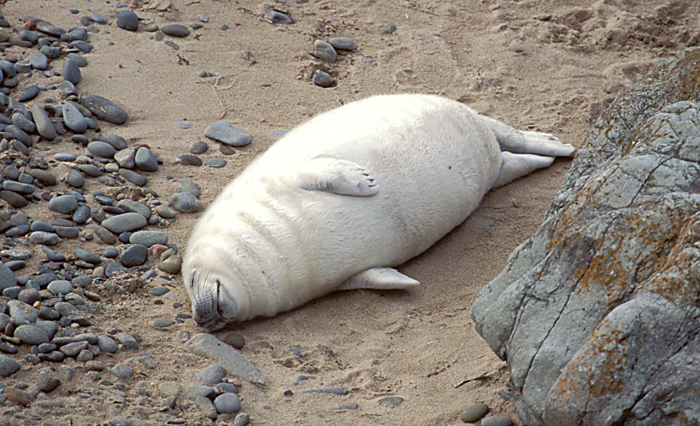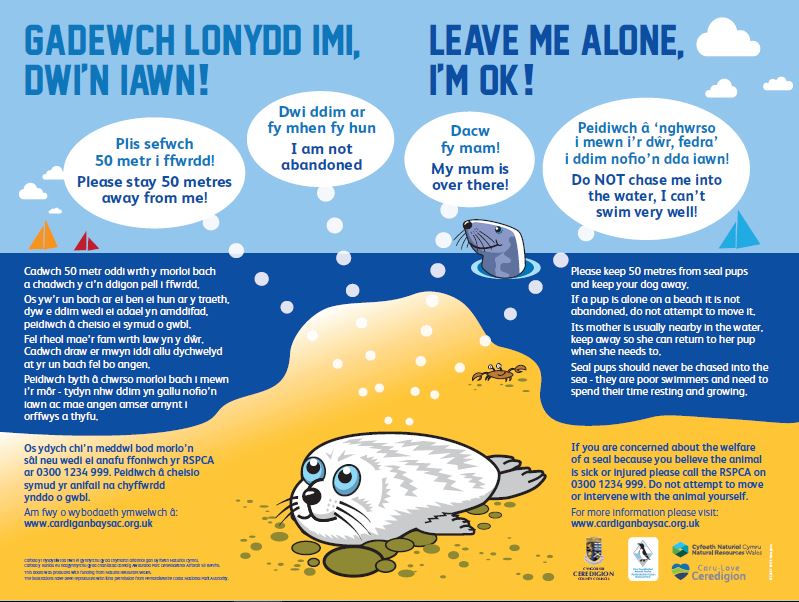Atlantic Grey Seal
Grey seals are known to range throughout the SAC and some 66 pups have been estimated to be born on beaches within the SAC each year.
Furthermore a tagging study modelling at-sea usage of the Irish Sea for grey seals has identified an area of high usage in the southern part of Cardigan Bay some 40-50 km offshore.
The diet of grey seals in West Wales is thought to consist mostly of whiting, flatfish, herring and dragonet.



Seal pupping season (September – November) – what can you do to help?
Like the dolphins of Cardigan Bay, we know that seals are foraging, breeding and socialising in the area. You can help by making every effort not to disturb their activities, especially while they are ashore with young.
Seals regularly haul out on beaches, rocky shores and in sea caves; this is part of their normal behaviour and allows time for them to digest their food and to rest. So finding a seal hauled out on the beach does not necessarily mean that the animal is sick or injured.
This is especially true during the pupping season, as at this time young seals can often appear abandoned. This is not usually the case, as they are left on the beach while their mothers are out foraging for food, and they should be left undisturbed. Seal pups should never be chased back into the sea – as this causes the pup significant distress and prevents them from doing what they need to do at this time – resting and growing. Suckling pups are also poor swimmers. The female will usually be offshore, but will not return to her pup if there are people around on the beach, and disturbance can threaten the mother-pup bond.
After stormy weather seals will often haul out to rest and regain their strength, many do not need assistance, but if you are concerned about the welfare of a seal, please contact the Marine Protected Area Officer, BDMLR or RSPCA (contact details below).
Do not attempt to move the animal yourself.
If you are concerned about disturbance of a seal pup on the Ceredigion coast please get in touch with the Cardigan Bay Marine Protected Area Officer, Melanie Heath at melanie.heath2@ceredigion.gov.uk or call 07707856891. In urgent cases where you believe the animal is sick or injured please report it to the RSPCA on 0300 1234 999 or the British Divers Marine Life Rescue on 01825 765546.
Do not attempt to move the animal yourself.

Description: Males or ‘bulls’ grow up to 3m and are generally darker than females or ‘cows’ that only grow up to 1.7m. Pups are white at birth, but turn a greyer colour within the first few weeks. They have a streamlined body, with a large nose and eyes.
Behaviour: They can often be seen surfacing near the shoreline while hunting and feeding but also go out to sea for long periods. Seals will dive for around eight minutes when foraging for food, but while at rest, or asleep, they may remain submerged for up to 13 minutes.
Diet: Fish, crustaceans & molluscs.
Reproduction: Female seals produce one pup a year during the autumn and have them ashore on the Bay’s secluded beaches and in sea caves.
Population: The UK hosts some 124 000 Atlantic grey seals (about 39% of the world population). In southwest Wales the population is estimated at 5,000.
Local numbers: Around 66 pups are estimated to be born in the SAC each year, around 17 of them between Ynys Lochtyn and New Quay Head.

